Application and Validation of a Municipal Administrative Area Spatial Zoning Model in Village-Town System Planning
Abstract
:1. Introduction
2. Research Method, Research Area, and Data Processing
2.1. Research Method
2.2. Present Situation of the Research Area, Contradictions of Various Kinds of Planning, and Explanation of Data Sources
2.3. Data Processing
3. Result
3.1. Model Validation and Comparative Application
3.1.1. Demarcation of Urban Growth Boundary
3.1.2. Land Use Planning
3.1.3. Spatial Governance Zoning
3.1.4. Key Village-town Planning
3.1.5. Industrial Land Layout
3.1.6. Location and Layout of Village Relocation and Consolidation
3.1.7. Timing-order of MAA Development
3.1.8. Village-town Scale
3.1.9. Functional Orientation of Villages and Towns in MAA
4. Discussion
4.1. The Explanation Degree of the M-MSZ Model Compared with the Contrasting Models and Government Behavior
4.2. Model Superiority
4.3. Application Scope and Inheritance of the M-MSZ Model
4.4. Enlightenment in the Development Modelling of Towns
5. Conclusions
Supplementary Materials
Author Contributions
Funding
Acknowledgments
Conflicts of Interest
References
- Bao, J.; Peng, Z.W. Conflict of Power and Rights and Spatial Mismatch of Rights on the Rural Homestead Approval: A Research from the Perspective of Land Development Right. Plan. Stud. 2017, 41, 35–40, 58. [Google Scholar] [CrossRef]
- Long, H.; Li, Y.; Liu, Y.; Woods, M.; Zou, J. Accelerated Restructuring in Rural China Fueled by ‘increasing Vs. Decreasing Balance’ Land-Use Policy for Dealing with Hollowed Villages. Land Use Policy 2012, 29, 11–22. [Google Scholar] [CrossRef]
- Ma, B.R.; Tian, G.J.; Kong, L.Q.; Liu, X.J. How China’s Linked Urban-Rural Construction Land Policy Impacts Rural Landscape Patterns: A Simulation Study in Tianjin, China. Landsc. Ecol. 2018, 33, 1417–1434. [Google Scholar] [CrossRef]
- Long, H.; Heilig, G.K.; Li, X. Socio-Economic Development and Land-Use Change: Analysis of Rural Housing Land Transition in the Transect of the Yangtse River, China. Land Use Policy 2007, 24, 141–153. [Google Scholar] [CrossRef]
- Chinigò, D. Rural Radicalism and the Historical Land Conflict in the Malawian Tea Economy. J. South. Afr. Stud. 2016, 42, 283–297. [Google Scholar] [CrossRef]
- García-Ayllón, S. Rapid development as a factor of imbalance in urban growth of cities in Latin America: A perspective based on territorial indicators. Habitat Int. 2016, 58, 127–142. [Google Scholar] [CrossRef]
- Saleh, A. Concept of Village Regrouping as an Alternative Strategy for Sustainable Micro Regional Development. In Proceedings of the Conference on Urban Zoning and Architectural Design for Sustainable Development (UPADSD), Lecce, Italy, 14–16 October 2015. [Google Scholar] [CrossRef]
- Owusu-Ansah, J.; Braimah, I. The dual land management systems as an influence on physical development outcomes around Kumasi, Ghana. J. Hous. Built Environ. 2013, 28, 689–703. [Google Scholar] [CrossRef]
- Hui, E.C.M.; Wu, Y.; Deng, L.; Zheng, B. Analysis on Coupling Relationship of Urban Scale and Intensive Use of Land in China. Cities 2015, 42, 63–69. [Google Scholar] [CrossRef]
- Zhong, T.; Qian, Z.; Huang, X.; Zhao, Y.; Zhou, Y.; Zhao, Z. Impact of the Top-Down Quota-Oriented Farmland Preservation Planning on the Change of Urban Land-Use Intensity in China. Habitat Int. 2018, 77, 71–79. [Google Scholar] [CrossRef]
- Orea, L.; Perez, J.A.; Roibas, D. Evaluating the Double Effect of Land Fragmentation on Technology Choice and Dairy Farm Productivity: A Latent Class Model Approach. Land Use Policy 2015, 45, 189–198. [Google Scholar] [CrossRef]
- Xia, N.K.; Wang, D.X. An Analysis on the Reform of Rural Land Circulation and Urban-Rural Planning. Urban Plan. Forum 2009, 82–88. [Google Scholar] [CrossRef]
- Short, A.G. Governing Change: Land-Use Change and the Prevention of Nonpoint Source Pollution in the North Coastal Basin of California. Environ. Manag. 2013, 51, 108–125. [Google Scholar] [CrossRef] [PubMed]
- Tilt, B. The Politics of Industrial Pollution in Rural China. J. Peasant Stud. 2013, 40, 1147–1164. [Google Scholar] [CrossRef]
- Godwin, I.; Ndukaku, O.; Emmanuel, I. Traditional Ruler, Environmental Education, Pollution and Rural Communities in Nigeria: Challenges and Prospects. Eur. J. Sustain. Dev. 2016, 5, 75–85. [Google Scholar] [CrossRef]
- Mahanty, S.; Dang, T. Between ‘State’ and ‘Society’: Commune Authorities and the Environment in Vietnam’s Craft Villages. Asia Pac. Viewp. 2015, 56, 267–281. [Google Scholar] [CrossRef]
- Gao, W.J.; Lian, Z.Q. The Planning of Village System. Small Town Plan. 2000, 24, 30–32. [Google Scholar] [CrossRef]
- Martinez, B.E. Adaptive Strategies: Migration and Labor Mobility in the Context of Globalization in Mexico. Rev. San Gregor. 2017, 18, 100–113. [Google Scholar]
- Yenigul, S.B. New Approaches in Rural Development Policies and the Effects of These Approaches on Turkey’s Rural Development Policies. Planlama-Plan. 2017, 27, 16–25. [Google Scholar] [CrossRef]
- Van, V.J.; De Groot, H.L.F.; Rietveld, P.; Verburg, P. Manifestations and Underlying Drivers of Agricultural Land Use Change in Europe. Landsc. Urban Plan. 2015, 133, 24–36. [Google Scholar] [CrossRef]
- Huang, Z.; Wei, Y.D.; He, C.; Li, H. Urban Land Expansion Under Economic Transition in China: A Multi-Level Modeling Analysis. Habitat Int. 2015, 47, 69–82. [Google Scholar] [CrossRef]
- Wang, Y.F.; Liu, Y.S.; Li, T.T. The Spatio-Temporal Patterns of Urban-Rural Development Transformation in China Since 1990. Habitat Int. 2016, 53, 178–187. [Google Scholar] [CrossRef]
- Shi, Y.S. A Summary of the Research on Village and Town System at Home and Abroad. Urban Plan. Int. 2007, 84–88. [Google Scholar] [CrossRef]
- Makki, M.S. Regional and Urban Population Size Weights in Saudi Arabia, 1962–1974. Geojournal 1986, 13, 111. [Google Scholar] [CrossRef] [PubMed]
- Chemisov, B.H.; Khusaynov, D.Y. A Mathematical Model of Hierarchical Structure of Rural Settlements Region. Sci. Bull. Polissia 2015, 2, 32–38. [Google Scholar]
- Lee, H.W. The Change of Rank-Size Distribution Under the Economic Development in Korea: 1995–2015. Korean Urban Geogr. Soc. 2017, 20, 45–57. [Google Scholar] [CrossRef]
- Mengue, A.; Khodja, A.; Gilg, J.P. Novel Approach to a Demographic Survey in Rural Africa by Remote Sensing: Adjustment of Official Census Data Using a Distribution Function. Int. J. Remote Sens. 1998, 19, 2705–2719. [Google Scholar] [CrossRef]
- Vollet, D. Estimating the Direct and Indirect Impact of Residential and Recreational Functions on Rural Areas: An Application to Five Small Areas of France. Eur. Rev. Agric. Econ. 1998, 25, 528–549. [Google Scholar] [CrossRef]
- Dou, Y.; Luo, X.; Dong, L.; Wu, C.; Liang, H.; Ren, J. An Empirical Study on Transit-Oriented Low-Carbon Urban Land Use Planning: Exploratory Spatial Data Analysis (ESDA) on Shanghai, China. Habitat Int. 2016, 53, 379–389. [Google Scholar] [CrossRef]
- Chang, N. A Grey Fuzzy Multiobjective Programming Approach for the Optimal Planning of a Reservoir Watershed. Part A: Theoretical Development. Water Res. 1996, 30, 2329–2334. [Google Scholar] [CrossRef]
- Liu, Y.; Lu, S.; Chen, Y. Spatio-Temporal Change of Urban-Rural Equalized Development Patterns in China and Its Driving Factors. J. Rural Stud. 2013, 32, 320–330. [Google Scholar] [CrossRef]
- Feng, S.; Xu, L.D. Hybrid Artificial Intelligence Approach to Urban Planning. Expert Syst. 2010, 16, 248–261. [Google Scholar] [CrossRef]
- Turner, B.L.; Wuellner, M.; Nichols, T.; Gates, R.N.; Tedeschi, L.; Dunn, B.H. Development and Evaluation of a System Dynamics Model for Investigating Agriculturally Driven Land Transformation in the North Central United States. Nat. Resour. Model. 2016, 29, 179–228. [Google Scholar] [CrossRef]
- Kluge, K.C.; Morgenthaler, M.K. Multihorizon Reactive and Deliberative Path Planning for Autonomous Cross-Country Navigation. Proceedings of SPIE. Int. Soc. Opt. Eng. 2004, 461–472. [Google Scholar] [CrossRef]
- Liu, Y.L.; Kong, X.S.; Liu, Y.F.; Chen, Y. Simulating the Conversion of Rural Settlements to Town Land Based on Multi-Agent Systems and Cellular Automata. PLoS ONE 2013, 8, e79300. [Google Scholar] [CrossRef] [PubMed]
- Zhang, L.; Wei, Y.H.; Meng, R. Spatiotemporal Dynamics and Spatial Determinants of Urban Growth in Suzhou, China. Sustainability 2017, 9, 393. [Google Scholar] [CrossRef]
- Wu, F.L. Calibration of Stochastic Cellular Automata: The Application to Rural-Urban Land Conversions. Int. J. Geogr. Inf. Sci. 2002, 16, 795–818. [Google Scholar] [CrossRef]
- Long, Y.; Shen, Z.J. Scenario Analysis of Beijing Urban form Based on Constrained CA Method. Acta Geogr. Sin. 2010, 65, 643–655. [Google Scholar] [CrossRef]
- Chuai, X.; Huang, X.; Wang, W.; Wu, C.; Zhao, R. Spatial Simulation of Land Use Based on Terrestrial Ecosystem Carbon Storage in Coastal Jiangsu, China. Sci. Rep. 2014, 4. [Google Scholar] [CrossRef] [PubMed]
- Wu, M.; Ren, X.Y.; Che, Y.; Yang, K. A Coupled SD and CLUE-S Model for Exploring the Impact of Land Use Change on Ecosystem Service Value: A Case Study in Baoshan District, Shanghai, China. Environ. Manag. 2015, 56, 402–419. [Google Scholar] [CrossRef] [PubMed]
- Rienow, A.; Goetzke, R. Supporting SLEUTH-Enhancing a Cellular Automaton with Support Vector Machines for Urban Growth Modeling. Comput. Environ. Urban Syst. 2015, 49, 66–81. [Google Scholar] [CrossRef]
- Xi, F.; He, H.S.; Clarke, K.C.; Hu, Y.; Wu, X.; Liu, M.; Shi, T.; Geng, Y.; Gao, C. The Potential Impacts of Sprawl on Farmland in Northeast China-Evaluating a New Strategy for Rural Development. Landsc. Urban Plan. 2012, 104, 34–46. [Google Scholar] [CrossRef]
- Kamusoko, C.; Aniya, M.; Adi, B.; Manjoro, M. Rural Sustainability Under Threat in Zimbabwe-Simulation of Future Land Use/Cover Changes in the Bindura District Based on the Markov-Cellular Automata Model. Appl. Geogr. 2009, 29, 435–447. [Google Scholar] [CrossRef]
- Chakraborti, S.; Das, D.N.; Mondal, B. A Neural Network and Landscape Metrics to Propose a Flexible Urban Growth Boundary: A Case Study. Ecol. Indic. 2018, 93, 952–965. [Google Scholar] [CrossRef]
- Fan, J.; Sun, W.; Yang, Z.S.; Fan, P.; Chen, D. Focusing on the Major Function-Oriented Zone: A New Spatial Planning Approach and Practice in China and Its 12th Five-Year Plan. Asia Pac. Viewp. 2012, 53, 86–96. [Google Scholar] [CrossRef]
- Wu, Y.; Peng, Y.; Zhang, X.; Skitmore, M.; Song, Y. Development Priority Zoning (DPZ)-Led Scenario Simulation for Regional Land Use Change: The Case of Suichang County, China. Habitat Int. 2012, 36, 268–277. [Google Scholar] [CrossRef]
- Peng, J.; Ma, J.; Yuan, Y.; Wei, H.; Pang, W. Integrated Urban Land-Use Zoning and Associated Spatial Development: Case Study in Shenzhen, China. J. Urban Plann. Dev. 2015, 141, 05014025. [Google Scholar] [CrossRef]
- Fan, J.; Li, X.P. The Scientific Foundation of China’s Main Function Regionalization. J. Geogr. Sci. 2009, 19, 5–21. [Google Scholar] [CrossRef]
- Chen, S.Z.; Zhou, Z.F.; Wang, P. A New Methodology to Quantitatively Define Major Function Oriented Zones of County: The Case of Libo County. In Proceedings of the 2016 International Conference on Environment, Climate Change and Sustainable Development (ECCSD 2016), Beijing, China, 28–29 May 2016; pp. 287–291. [Google Scholar]
- Fan, J.; Sun, W.; Zhou, K.; Chen, D. Major Function Oriented Zone: New Method of Spatial Regulation for Reshaping Regional Development Pattern in China. Chin. Geogr. Sci. 2012, 22, 196–209. [Google Scholar] [CrossRef]
- Yasi, T.; Xuesong, K.; Yaolin, L. Combining Weighted Daily Life Circles and Land Suitability for Rural Settlement Reconstruction. Habitat Int. 2018, 76, 1–9. [Google Scholar] [CrossRef]
- Zhu, C.B.; Deng, Y.D. Basic Methods on Regional Orientation. City Plan. Rev. 2000, 32–35. [Google Scholar] [CrossRef]
- Christiane, W. Interaction Model Application for Urban Planning. Urban Plan. Int. 2006, 21, 77–82. [Google Scholar] [CrossRef]
- Abedini, A.; Ebrahimkhani, H.; Abedini, B. Mixed Method Approach to Delineation of Functional Urban Regions: Shiraz Metropolitan Region. Urban Plan. Dev. 2016, 142, 23–29. [Google Scholar] [CrossRef]
- Jacques, L. A Model of Urbanization with Nonlinear Migration Flows. Int. Reg. Sci. Rev. 1986, 10, 221–242. [Google Scholar] [CrossRef]
- Batty, M. A Strategy for Generating and Testing Models of Migration and Urban-Growth. Reg. Stud. 1983, 17, 223–236. [Google Scholar] [CrossRef] [PubMed]
- Rem, G.P.; Liu, L.M.; Sun, J.; Zhuo, D.; Yuan, C. Using the “Cell-Chain-Shape” Method to Identify and Classify Spatial Development Patterns of Administrative Villages in the Metropolitan Suburbs. Acta Geogr. Sin. 2017, 72, 2147–2165. [Google Scholar] [CrossRef]
- Xiong, H.; Zheng, B.; Jia, L. Research on the Integration of Towns Based on Industrial Coordinated Development—Taking Changsha Area as an Example. Econ. Geogr. 2017, 37, 124–131. [Google Scholar] [CrossRef]
- Kong, X.S.; Jin, L.L.; Qie, Y.; Zhang, Y.; Xu, Y. Layout Optimization of Rural Settlements Based on Point-Axis Theory. Trans. Chin. Soc. Agric. Eng. (Trans. CSAE) 2014, 30, 192–200. [Google Scholar] [CrossRef]
- Gong, J.; Liu, Y.; Chen, W. Land Suitability Evaluation for Development Using a Matter-Element Model: A Case Study in Zengcheng, Guangzhou, China. Land Use Policy 2012, 29, 464–472. [Google Scholar] [CrossRef]
- Cengiz, T.; Akbulak, C. Application of Analytical Hierarchy Process and Geographic Information Systems in Land-Use Suitability Evaluation: A Case Study of DÜMrek Village (Canakkale, Turkey). Int. J. Sustain. Dev. World Ecol. 2009, 16, 286–294. [Google Scholar] [CrossRef]
- Liu, Y.; Cui, J.; Kong, X.; Chen, Z. Assessing Suitability of Rural Settlements Using An Improved Technique for Order Preference by Similarity to Ideal Solution. Chin. Geogr. Sci. 2016, 26, 638–655. [Google Scholar] [CrossRef]
- Liu, Y.; Ye, Q.; Li, J.; Kong, X.; Jiao, L. Suitability Evaluation of Rural Settlements Based on Accessibility of Production and Living: A Case Study of Tingzu Town in Hubei Province of China. Chin. Geogr. Sci. 2016, 26, 550–565. [Google Scholar] [CrossRef]
- Jiang, R.; Qiu, J. Exploration and Reflections on Village-Town Planning of Chengdu in the Context of Urban-Rural Integration. City Plan. Rev. 2012, 36, 86–91. [Google Scholar]
- Zhao, Y.J.; Leng, H.; Sun, P.J.; et al. A Spatial Zoning Model of Municipal Administrative Areas Based on Major Function-Oriented Zones. Sustainability 2018, 10, 2976. [Google Scholar] [CrossRef]
- Mazzocchi, C.; Corsi, S.; Sali, G. Agricultural Land Consumption in Periurban Areas: A Methodological Approach for Risk Assessment Using Artificial Neural Networks and Spatial Correlation in Northern Italy. Appl. Spat. Anal. Policy 2017, 10, 3–20. [Google Scholar] [CrossRef]
- Kamali, F.P.; Borges, J.A.R.; Meuwissen, M.; et al. Sustainability Assessment of Agricultural Systems: The Validity of Expert Opinion and Robustness of a Multi-Criteria Analysis. Agric. Syst. 2017, 157, 118–128. [Google Scholar] [CrossRef]
- Evett, R.R.; Cuthrell, R.Q. A conceptual framework for a computer-assisted, morphometric-based phytolith analysis andclassification system. J. Archaeol. Sci. 2016, 68, 70–78. [Google Scholar] [CrossRef]
- Zhao, X.; Huang, Q.X.; He, C.Y. Scenarios Simulation of the Spatial Stress on Wetlands by Urban Expansion: A Case Study of Huailai County. J. Nat. Resour. 2017, 9, 108–115. [Google Scholar] [CrossRef]
- Xia, C.; Wang, H.J.; Zhang, A.Q. Multi-Scenario Simulation and Policy Analysis of Urban Space Under the Effects of Coupling and Control Ling. Hum. Geogr. 2017, 32, 67–76. [Google Scholar] [CrossRef]
- Zhang, T.; Wang, Y.L.; Liu, Y.X.; Peng, J. Multi-Temporal Detection of Landscape Evolution in Western Shenzhen City During 1987–2015. Acta Geogr. Sin. 2016, 71, 2170–2184. [Google Scholar] [CrossRef]
- Wu, Y.Z.; You, H.Y.; Chen, Q.H. Study on Strategic Planning Technique Based on Multi-Dimensional Gis-Scenario Analysis. City Plan. Rev. 2014, 38, 35–43. [Google Scholar] [CrossRef]
- Arsanjani, J.J.; Helbich, M.; Kainz, W.; Boloorani, A.D. Integration of Logistic Regression, Markov Chain and Cellular Automata Models to Simulate Urban Expansion. Int. J. Appl. Earth Obs. Geoinform. 2013, 21, 265–275. [Google Scholar] [CrossRef]
- Long, H.; Zou, J.; Pykett, J.; Li, Y.R. Analysis of Rural Transformation Development in China Since the Turn of the New Millennium. Appl. Geogr. 2011, 31, 1094–1105. [Google Scholar] [CrossRef]
- Marwa, W.A.; Halmy, P.E.; Gessler, J.A.; Hicke BB, S. Land Use/Land Cover Change Detection and Prediction in the North-Western Coastal Desert of Egypt Using Markov-CA. Appl. Geogr. 2015, 63, 101–112. [Google Scholar] [CrossRef]
- Gashaw, T.; Tulu, T.; Argaw, M.; Abeyou, W.W.; Terefe, T.; Mengistie, K. Estimating the Impacts of Land Use/Land Cover Changes on Ecosystem Service Values: The Case of the Andassa Watershed in the Upper Blue Nile Basin of Ethiopia. Ecosyst. Serv. 2018, 31, 219–228. [Google Scholar] [CrossRef]
- Bryan, B.A.; Ye, Y.Q.; Zhang, J.E. Land-Use Change Impacts on Ecosystem Services Value: Incorporating the Scarcity Effects of Supply and Demand Dynamics. Ecosyst. Serv. 2018, 32, 144–157. [Google Scholar] [CrossRef]
- Du, Q.Y.; Wang, L.; Ren, F.; Zhao, Z.Y. Measuring and Analysis of Urban Competitiveness of Chinese Provincial Capitals in 2010 Under the Constraints of Major Function-Oriented Zoning Utilizing Spatial Analysis. Sustainability 2014, 6, 3374–3399. [Google Scholar] [CrossRef]
- Liu, W.; Liu, J.; Kuang, W.; Ning, J. Examining the Influence of the Implementation of Major Function-Oriented Zones on Built-Up Area Expansion in China. J. Geogr. Sci. 2017, 27, 643–660. [Google Scholar] [CrossRef]
- Ren, G.P. The Evolution and Development Model of Rural Landscape Under the Background of Rapid Urbanization. Ph.D. Thesis, China Agricultural University, Beijing, China, 2018. [Google Scholar]
- Zhu, L.; Xiao, L.S.; Guo, Q.H. Research on coupling pattern between urbanization and industrial structure: A case study in rapid urbanizing Xia-Zhang-Quan area. China Popul. Resour. Environ 2017, 25, 98–102. [Google Scholar] [CrossRef]
- Sun, J.W.; Luo, J.; Kong, X.S. Zoning and Potential Calculation for Rural Settlements Consolidation 1n Qinba Mountainous Area Based on Spatial Characteristics. Hum. Geogr. 2017, 32, 80–87, 94. [Google Scholar] [CrossRef]
- Sun, J.W.; Kong, X.S.; Tian, Y.S.; Luo, J. Identifying Reconstruction Directions of Rural Settlements Based on Analysis of Spatial Combination Features. Sci. Geogr. Sin. 2017, 5, 111–118. [Google Scholar] [CrossRef]
- Zolekar, R.B.; Bhagat, V.S. Multi-Criteria Land Suitability Analysis for Agriculture in Hilly Zone: Remote Sensing and GIS Approach. Comput. Electron. Agric. 2015, 118, 300–321. [Google Scholar] [CrossRef]
- Ayla, B.; Yavuz, F.; Aslı, S.G. AHP and GIS Based Land Suitability Analysis for Cihanbeyli (Turkey) County. Environ. Earth Sci. 2016, 75, 813. [Google Scholar] [CrossRef]
- Yalew, S.G.; van Griensven, A.; Mul, M.L.; van der Zaag, P. Land Suitability Analysis for Agriculture in the Abbay Basin Using Remote Sensing, GIS and AHP Techniques. Model. Earth Syst. Environ. 2016, 2, 101. [Google Scholar] [CrossRef]
- Huang, Q.; Liu, Y.; Li, M.; Mao, K.; Li, F.X.; Chen, Z.J.; Chen, C.; Hu, W. Thematic Maps for County-Level Land Use Planning in Contemporary China. J. Maps 2012, 8, 185–188. [Google Scholar] [CrossRef]
- Song, J.T.; Gu, C.L. Theory and Method of Urban System Planning. Acta Geogr. Sin. 1988, 2, 97–107. [Google Scholar] [CrossRef]
- Available online: https://baike.baidu.com/item/%E5%9F%8E%E9%95%87%E4%BD%93%E7%B3%BB%E8%A7%84%E5%88%92/7788425?fr=Aladdin (accessed on 13 December 2014).
- Available online: https://baike.baidu.com/item/%E6%9D%91%E9%95%87%E8%A7%84%E5%88%92/1918708?fr=Aladdin (accessed on 13 January 2016).
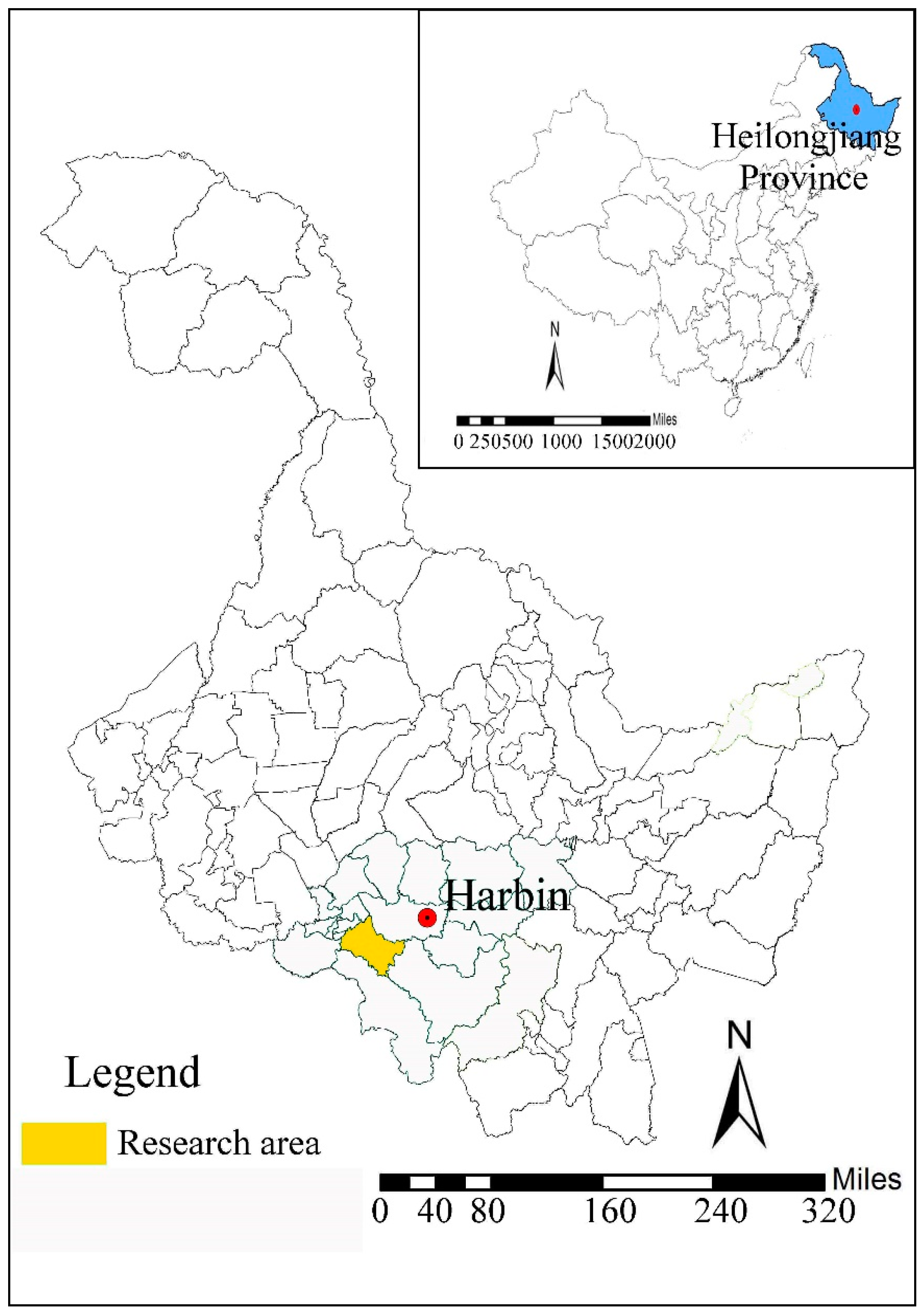
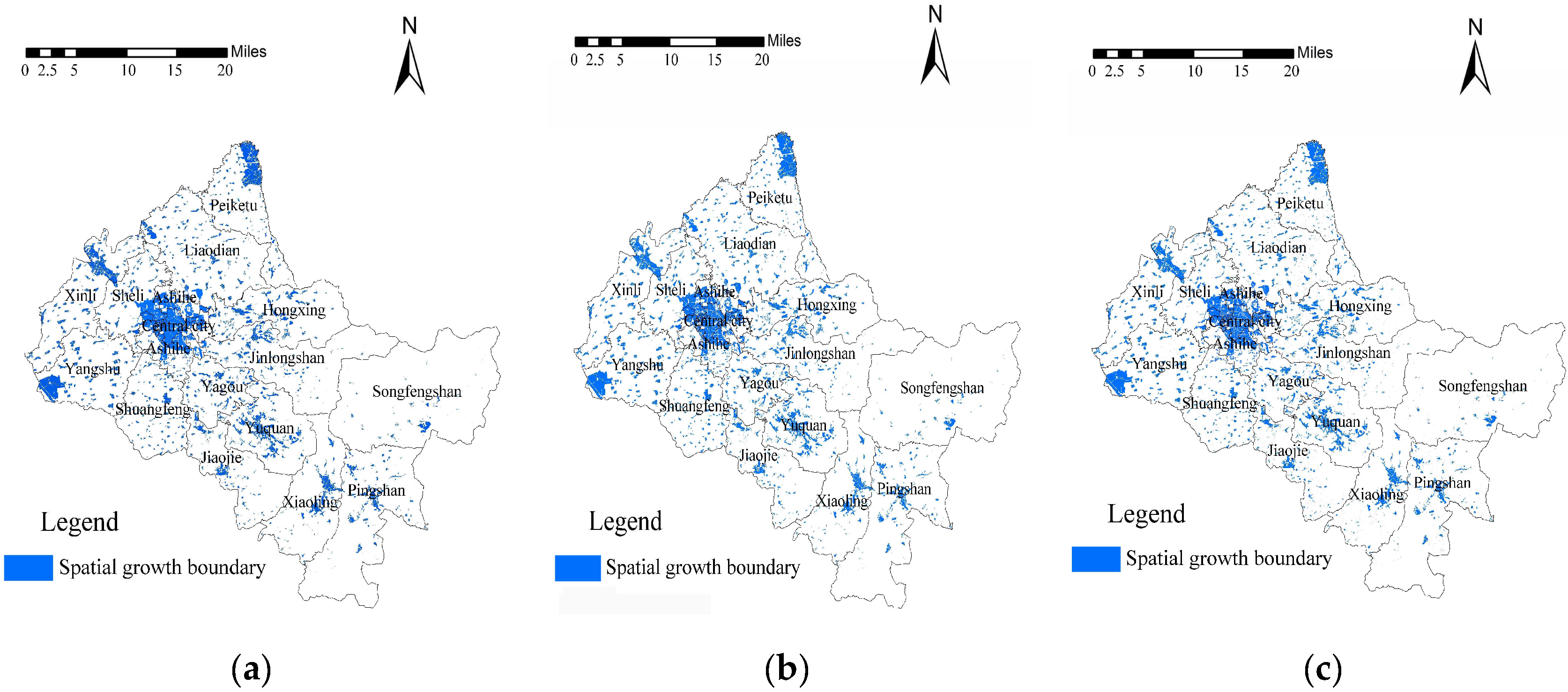
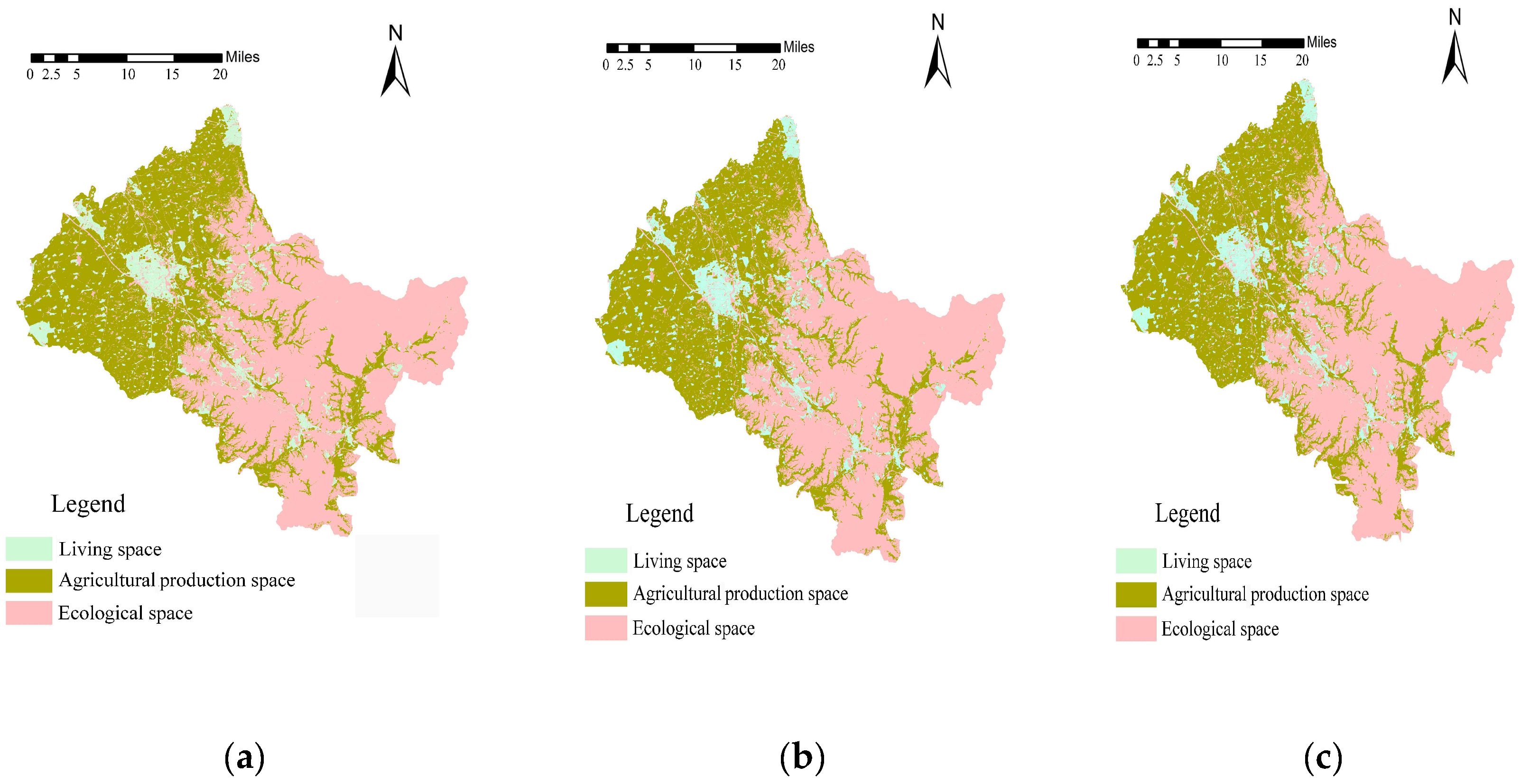
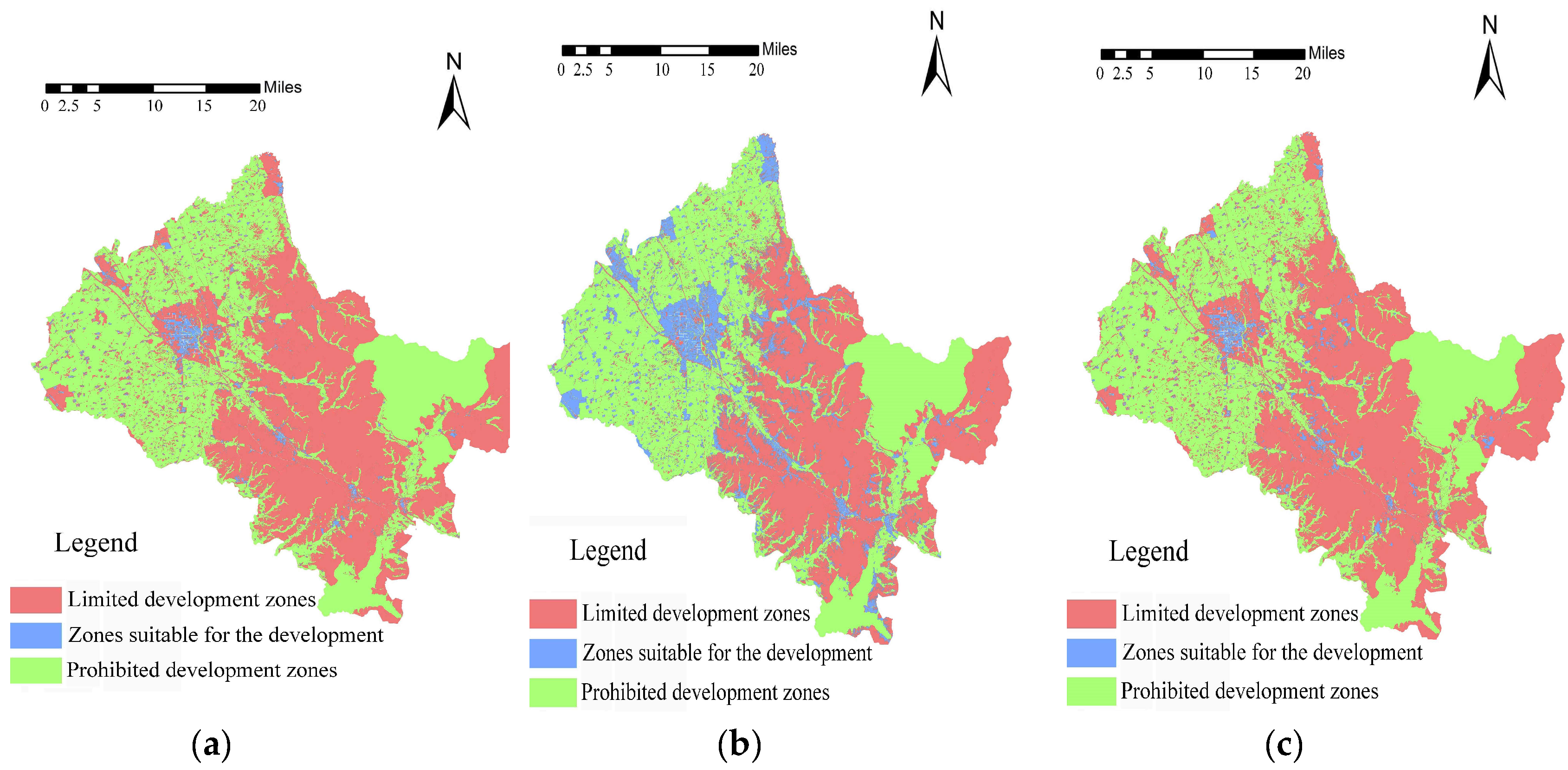
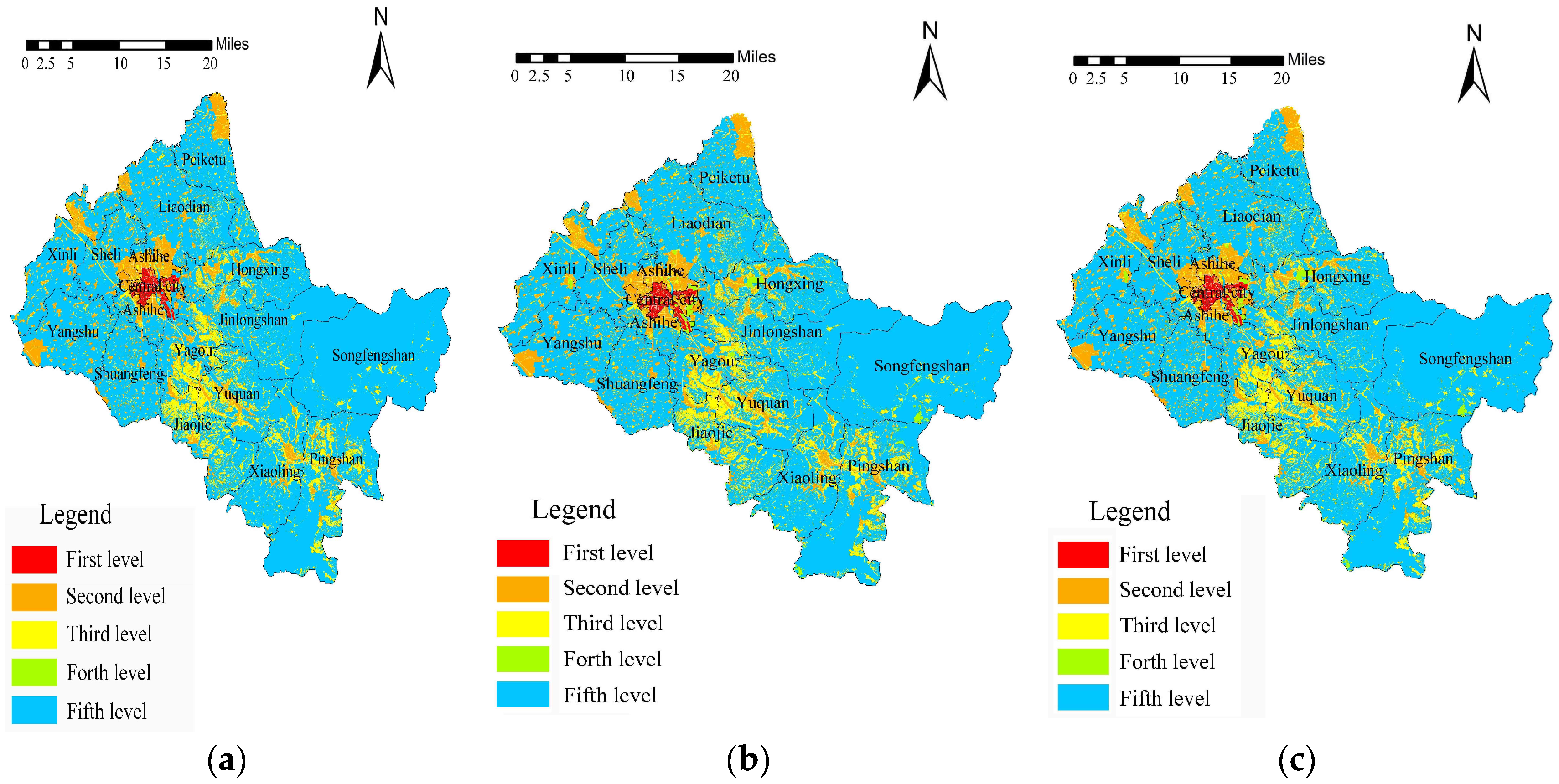
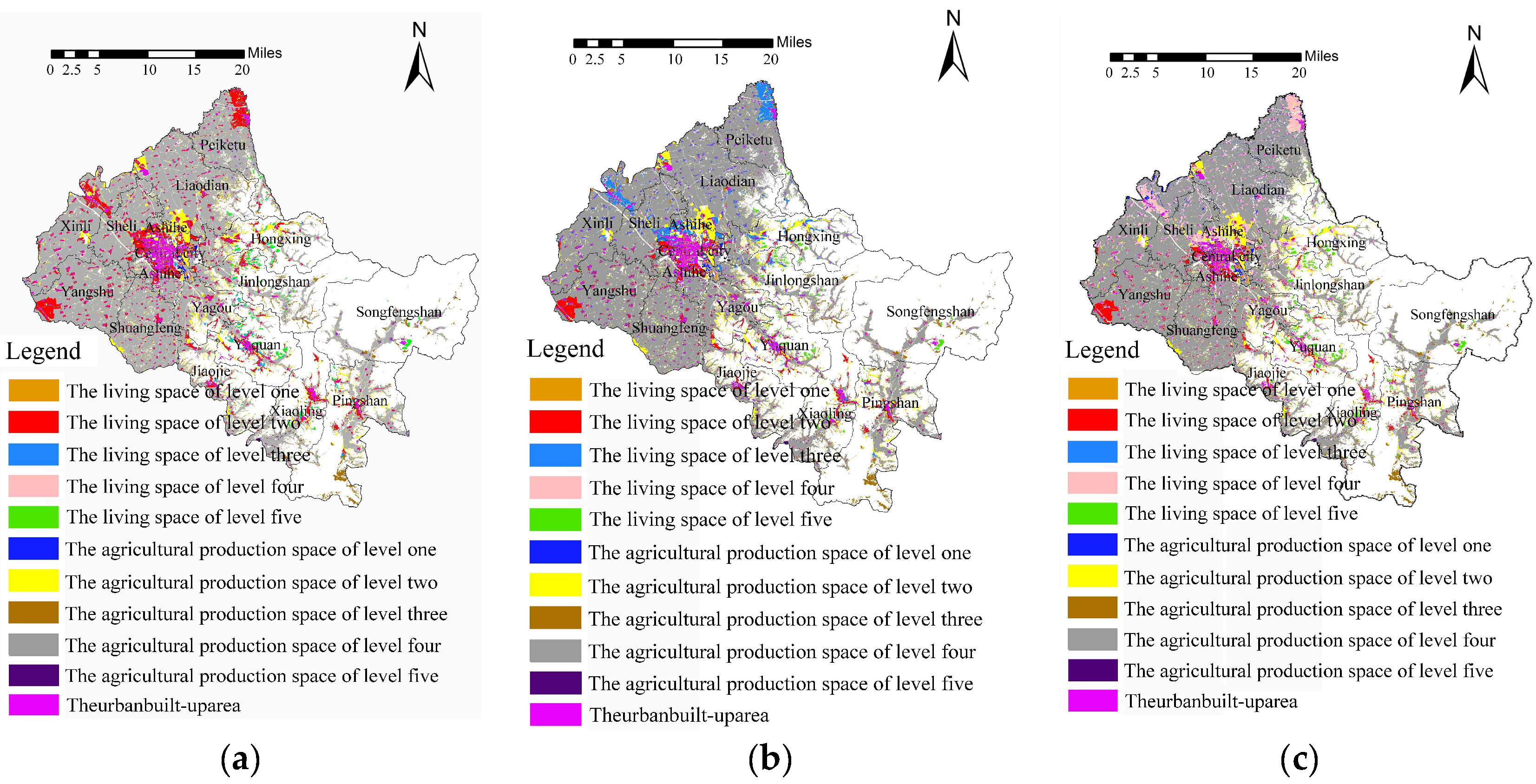
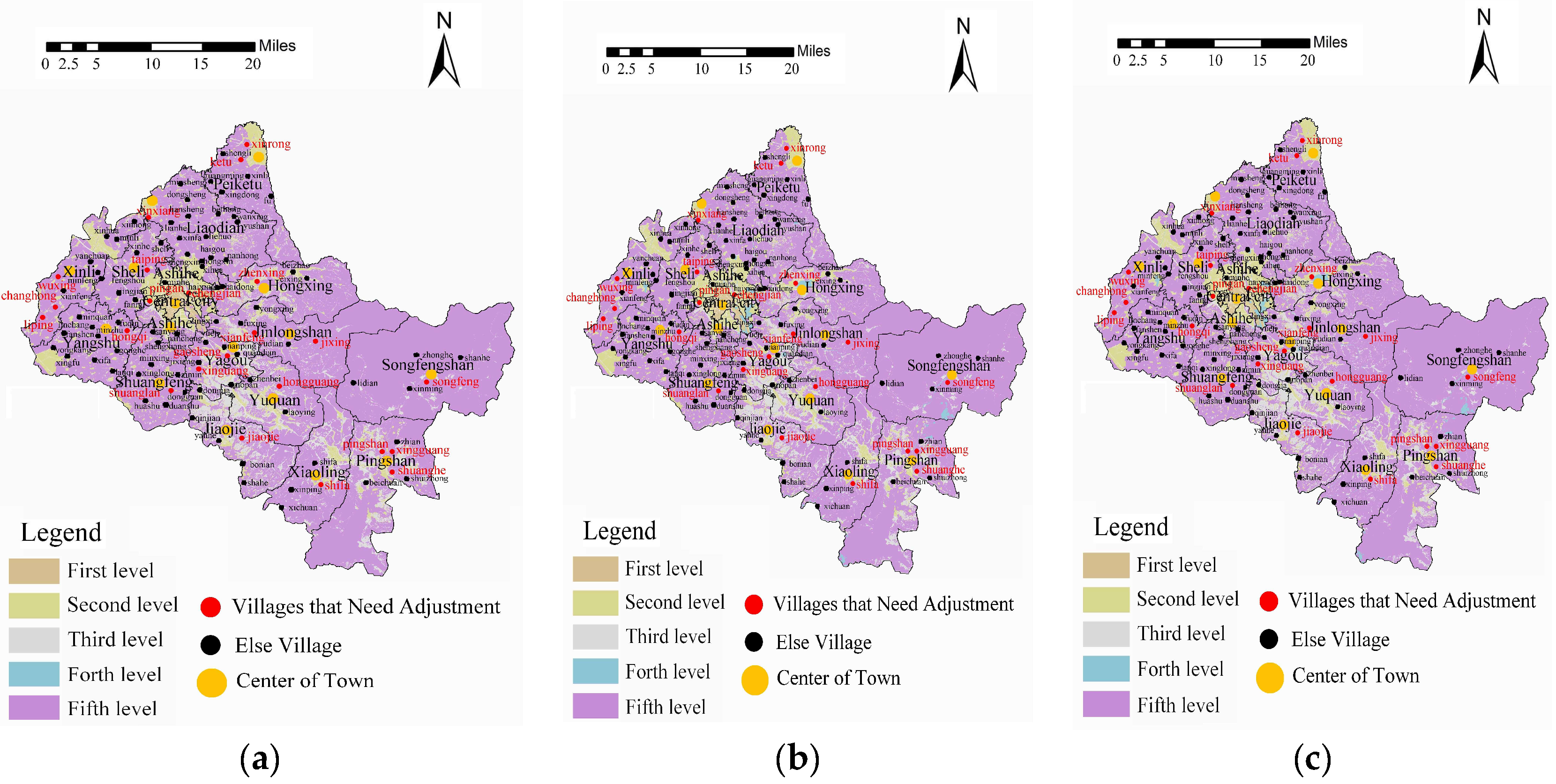
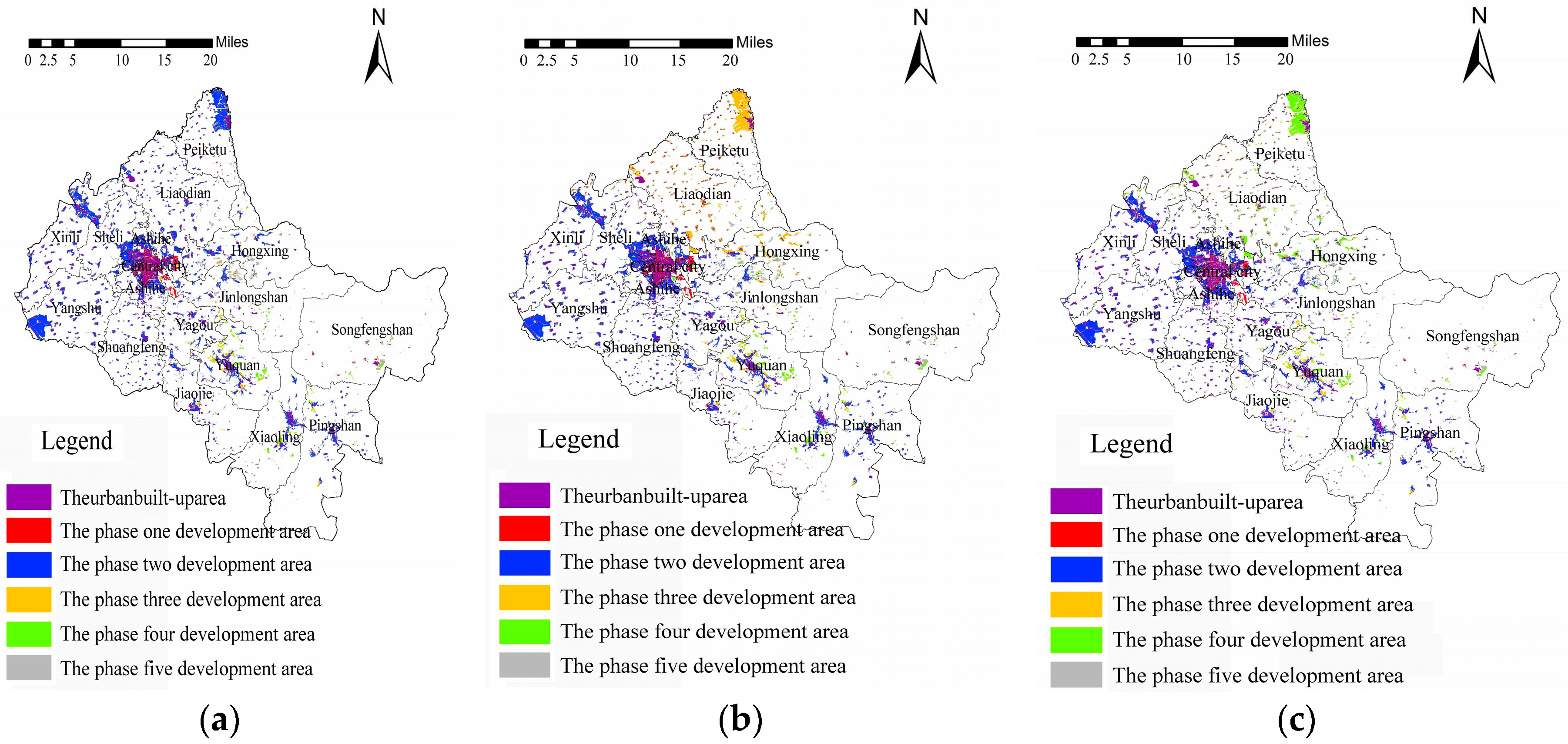
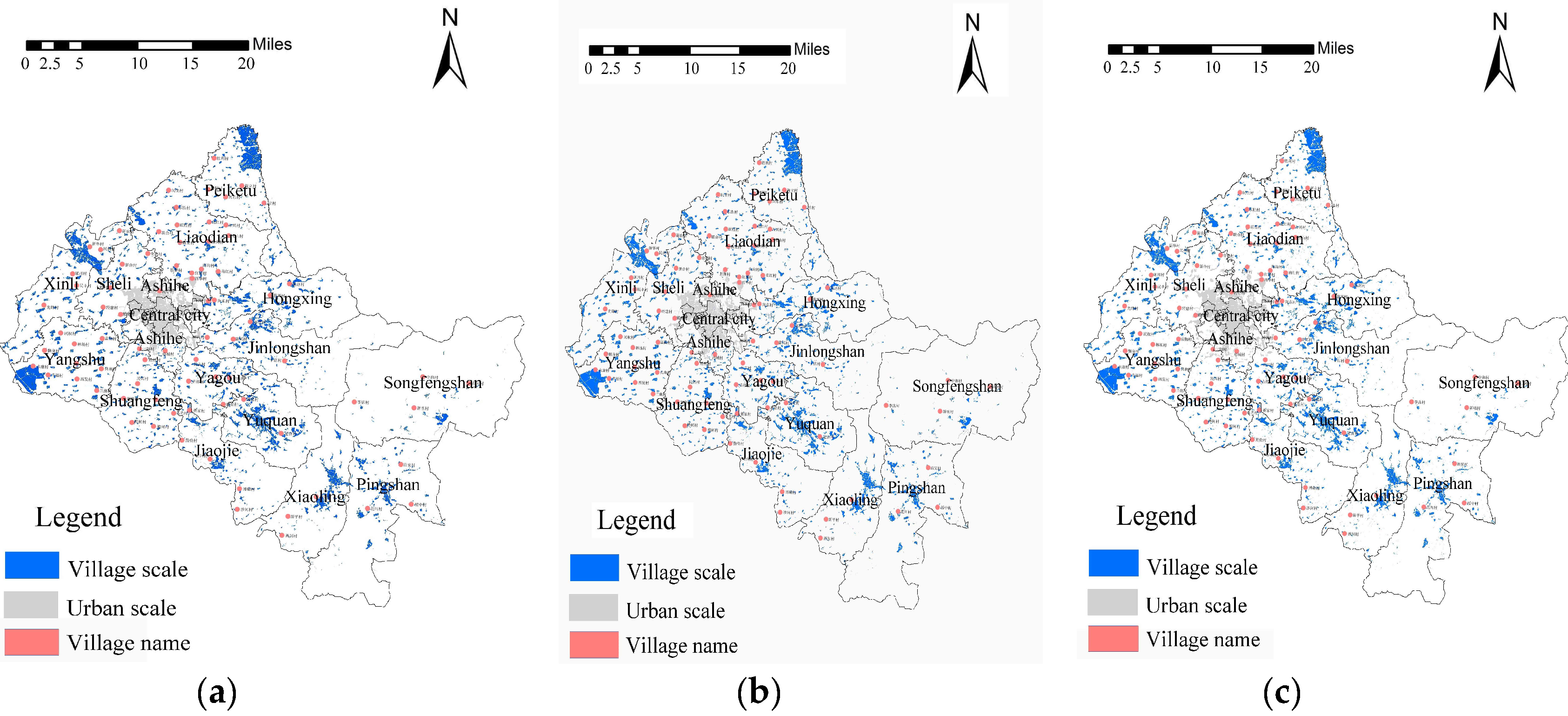
| Factors of the M-MSZ Model | Level | |||||
|---|---|---|---|---|---|---|
| 1 | 2 | 3 | 4 | 5 | ||
| Population Quantity | Growth Rate of Population | >10‰ | 3‰–10‰ | −3‰–3‰ | −10‰–−3‰ | <−10‰ |
| D Value | 1.8 | 1.6 | 1.4 | 1.2 | 0.8 | |
| Economic Situation | Economic Growth Intensity | >20% | 15%–20% | 10%–15% | 0%–10% | <0% |
| K Value | 1.5 | 1.4 | 1.3 | 1.2 | 1 | |
| Transport Superiority Degree | Railway Stations, Expressways and Main Roads at All Levels (Km) | <2 | 2–3 | 3–4 | 4–6 | >6 |
| Arterial Airport (Km) | <30 | 30–60 | 60–90 | 90–120 | >120 | |
| Regional Airports and Ports (Km) | <20 | 20–30 | 30–40 | 40–60 | >60 | |
| Superimposed Fraction | 15 | 12–14 | 9–11 | 6–8 | 3–5 | |
| Location Advantage | Inner Location Advantage | Divide into Five Grades with Equidistant Way | ||||
| Exterior Location Advantage | 0–30 | 30–60 | 60–90 | 90–120 | >120 | |
| Superimposed Fraction | 10 | 8–9 | 6–7 | 4–5 | 2–3 | |
| Topographic and Terrain | Height (M) | 0–210 | 200–500 | 500–1000 | 1000–1350 | >1350 |
| Slope (°) | ≤3 | 3–10 | 10–15 | 15–50 | >50 | |
| Superimposed Fraction | 10 | 8–9 | 6–7 | 4–5 | 2–3 | |
| Utilization of Land Resources | Area (Km2) | >320 | 200–320 | 150–200 | 100–150 | <100 |
| Utilization of Water Resources | Utilization of Water Resources Per Capita (M3/Capita) | 2000–3200 | 1500–2000 | 1000–1500 | 500–1000 | 0–500 |
| Number * | ≥4 | 3 | 2 | 1 | 0 | |
| Natural Disaster | Risk of Floods, Droughts, Earthquakes and Forest Fires | No | Common | Great | Significant | Outsize |
| Environmental Capacity | ai: Capacity Indicator for Individual Environmental Capacity) | Ai ≤ 0 | 0 < ai < 1 | 1 < ai < 1.5 | 1.5 < ai < 2 | ai≥2 |
| Ecosystem Vulnerability | Evaluation Results of Ecological Vulnerability | 0–0.2 | 0.2–0.4 | 0.4–0.6 | 0.6–0.8 | 0.8–1.0 |
| Town | Central Urban Area | Peiketu Town | Liaodian Town | Jinlongshan Town | |
|---|---|---|---|---|---|
| Simulation Results of the M-MSZ Model | Dominant Factors | First-level Economic Situation | First-level Economic Situation | First-level Economic Situation | First-level Ecosystem Vulnerability |
| First-level Population Aggregation | First-level Population Aggregation | First-level Population Aggregation | First-level Economic Situation | ||
| First-level Transportation Advantages | Second-level Transportation Advantages | Second-level Transportation Advantages | Second-level Natural Environmental Capacity | ||
| First-level Location Advantage | Second-level Location Advantage | Second-level Location Advantage | Second-level Transportation Advantages | ||
| Number of Development Zones That Is Not Built Up, Or Development Zones Undeveloped After Adjusted by the State or Government, Second-level | Second-level Available Land Resources | Second-level Available Land Resources | Second-level Location Advantage | ||
| Main Economic Sectors | Trade and Service industry, Logistics | Food Processing and Logistics | Logistics, Planting of Agricultural Products, Trade and Service industry | Tourism industry | |
| Major Function Orientation | Suitable Development Space | Suitable for Agricultural Production Space | Suitable for Agricultural Production Space | Suitable Ecological Protection Space | |
| Function of the M-MSZ | Mainly on Trade and Service industry, Living and Logistics | Food Processing, Logistics, Planting and Processing of Agricultural Products, Trade and Service industry | Mainly on Trade and Service industry, Logistics, Planting and Processing of Agricultural Products, Living | Mainly on the Tourism industry | |
| Simulation Results of the Contrast Model | Main Attraction Factor | Central Urban Area, Trade and Service industry, Logistics | Food Processing, Logistics, Planting and Processing of Agricultural Products, Trade and Service industry | Trade and Service industry, Logistics, Planting of Agricultural Products | Tourism Industry |
| Function of the contrast model | Mainly on Trade and Service industry, Logistics | Mainly on Food Processing, Logistics, Planting and Processing of Agricultural Products, Trade and Service industry | Mainly on Trade, Logistics, Planting of Agricultural Products | Mainly on the Tourism industry | |
| Government Behavior Results | Function of Government Planning | Mainly on Tourism, Trade and Service industry, Living and Logistics | Food Processing, Logistics, Trade and Service industry, Living | Mainly on Trade, Logistics, Planting of Agricultural Products | Mainly on the Tourism industry |
| Village-town System Planning | The Contrast Model | Kappa Value | R2 of the MMA-SZ Model | R2 of the Contrast Model | ||
|---|---|---|---|---|---|---|
| The MMA-SZ Model & Contrast Model | The MMA-SZ Model & Government Behavior | Contrast Model & Government Behavior | ||||
| Urban growth boundary Zoning | UGB model | 78.20% | 83.80% | 77.60% | 0.77 | 0.75 |
| Land Use Planning | Land Use Planning Model | 83.30% | 85.10% | 80.24% | 0.83 | 0.79 |
| Spatial Governance Zoning | Spatial Governance Zoning Model | 89.30% | 84.20% | 81.20% | 0.81 | 0.80 |
| MAA Development Timing-order | Development Timing-order and Zoning Model | 75.70% | 85.10% | 83.40% | 0.78 | 0.77 |
| Key Village-Town Planning | Various Models for Location and Layout | 87.70% | 81.20% | 81.40% | 0.84 | 0.83 |
| Industrial Land Layout | 82.30% | 84.10% | 83.50% | 0.69 | 0.69 | |
| Location and Layout of Village Relocation and Consolidation | 79.40% | 81.40% | 79.50% | 0.75 | 0.76 | |
| Village-town scale | Scale-Level and Functional Zoning Model | 84.7% | 83.5% | 82.6% | 0.82 | 0.81 |
© 2019 by the authors. Licensee MDPI, Basel, Switzerland. This article is an open access article distributed under the terms and conditions of the Creative Commons Attribution (CC BY) license (http://creativecommons.org/licenses/by/4.0/).
Share and Cite
Zhao, Y.; Leng, H.; Sun, P.; Yuan, Q. Application and Validation of a Municipal Administrative Area Spatial Zoning Model in Village-Town System Planning. Sustainability 2019, 11, 1855. https://doi.org/10.3390/su11071855
Zhao Y, Leng H, Sun P, Yuan Q. Application and Validation of a Municipal Administrative Area Spatial Zoning Model in Village-Town System Planning. Sustainability. 2019; 11(7):1855. https://doi.org/10.3390/su11071855
Chicago/Turabian StyleZhao, Yujing, Hong Leng, Pingjun Sun, and Qing Yuan. 2019. "Application and Validation of a Municipal Administrative Area Spatial Zoning Model in Village-Town System Planning" Sustainability 11, no. 7: 1855. https://doi.org/10.3390/su11071855
APA StyleZhao, Y., Leng, H., Sun, P., & Yuan, Q. (2019). Application and Validation of a Municipal Administrative Area Spatial Zoning Model in Village-Town System Planning. Sustainability, 11(7), 1855. https://doi.org/10.3390/su11071855






